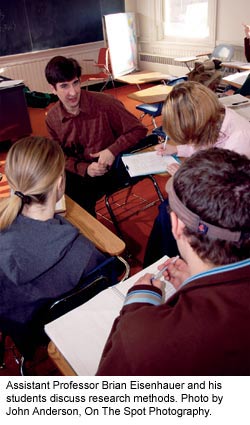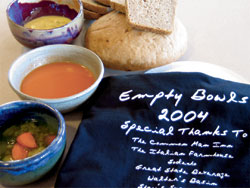by Kristin Proulx Jarvis
 Brian Eisenhauer wanted students in his research methods class to experience a taste of real-world research. The Squam Lakes Natural Science Center-an educational center in Holderness visited by thousands of schoolchildren each year-needed to design an evaluation of their exhibit on solar energy. So last year, Eisenhauer (an assistant professor in PSU’s social science department) gave his students the task of creating a research design, distributing questionnaires to visitors and compiling the results in a report for the Science Center. The students’ research showed that visitors found the exhibit educational, interesting and effective. The research also offered the Science Center important feedback on what types of exhibits worked for visitors, and which failed.
Brian Eisenhauer wanted students in his research methods class to experience a taste of real-world research. The Squam Lakes Natural Science Center-an educational center in Holderness visited by thousands of schoolchildren each year-needed to design an evaluation of their exhibit on solar energy. So last year, Eisenhauer (an assistant professor in PSU’s social science department) gave his students the task of creating a research design, distributing questionnaires to visitors and compiling the results in a report for the Science Center. The students’ research showed that visitors found the exhibit educational, interesting and effective. The research also offered the Science Center important feedback on what types of exhibits worked for visitors, and which failed.
With that research project, a new partnership between PSU and the Science Center was born.
This fall, the Science Center again asked Eisenhauer if his students could act as consultants on not one, but two research projects. Twenty students in the professor’s Research Methods class designed an evaluation of the Center’s whitetail deer exhibit, and another group of student volunteers prepared a report on the financial feasibility and visitor support for opening a new exhibit featuring a live moose.
Eisenhauer says his students have invested a lot of time, thought and care into these projects, which have proved much more meaningful than any artificial research scenario the professor could have invented.
“This information will really be used,” said Eisenhauer. “It’s one of those situations where everyone is benefiting.”
During the research methods class, students spent an afternoon at the Science Center researching the deer exhibit. Later in the semester, members of the Science Center staff came to PSU for a “consultant’s meeting,” said Eisenhauer. Staff and students worked together to design an evaluation that includes questionnaires for visitors, observation periods at the exhibit and interviews with focus groups. Data will be gathered in the spring and summer. The research is funded by the Science Center as well as a $500 faculty development grant from PSU.
Kathryn Welles, a senior sociology major in the research class, said working “hands-on” in research made the process easier to understand and the project much more interesting. Because the Science Center project was real research, Welles said she and her classmates felt more motivation to design an effective evaluation for the exhibit.
“I wanted to be successful, covering what they wanted and meeting their goal,” she said.
The research design was also good practice for spring semester, when Welles will design and conduct her own research project during a senior seminar required for her sociology major.
Jim Eckert, the Science Center’s director of trails and exhibits, called the collaboration with PSU students successful and economical. Employing students to evaluate exhibits has saved the Center staff time and money. Eckert said he hopes to continue to work with PSU students to evaluate each of the Center’s dozens of exhibits.
“Knowing whether [the exhibits] are effective at educating will streamline the process of replacement, resulting in a more efficient use of the Center’s resources and a more fruitful experience for the Center’s visitors,” Eckert said.








